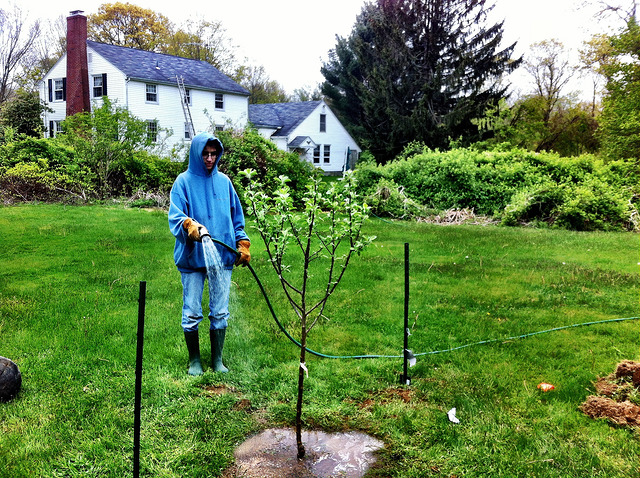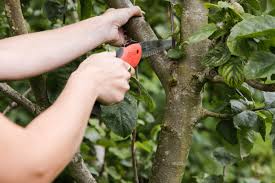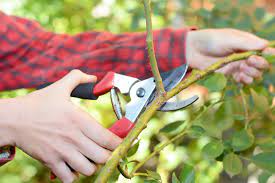Caring for fruit trees is a rewarding endeavor that can yield delicious harvests and enhance the beauty of your landscape. Proper care involves several key aspects, including choosing the right variety, planting correctly, watering, pruning, fertilizing, managing pests and diseases, and harvesting. Here are the details “how to care for fruit trees”:
Choosing the right fruit trees
Here are the details:

Climate considerations
When selecting fruit trees, it’s crucial to consider your local climate. Different fruit trees have varying temperature and sunlight requirements, so understanding your growing conditions is essential.
- Hardiness zones: The USDA hardiness zone map divides the United States into different zones based on average minimum winter temperatures. Research your zone to identify which fruit trees can thrive in your area. For example, apples, cherries, and pears do well in colder regions, while peaches, citrus, and figs prefer warmer climates.
- Local varieties: In addition to climate, consider choosing varieties that are well-adapted to local conditions. These varieties are often more resistant to local pests and diseases and can produce better yields. Local agricultural extension services or garden centers can provide valuable information about the best varieties for your area.
Space requirements
Space is another critical factor when choosing fruit trees. Ensure you have enough room for the tree to grow to its full size without overcrowding.
- Mature size: Determine the mature size of the tree you wish to plant. Dwarf and semi-dwarf varieties are ideal for smaller spaces and can often be grown in containers, while standard varieties require more room to spread out. Dwarf trees usually reach a height of 8 to 10 feet, while standard trees can grow 15 to 25 feet tall.
- Planting distance: Space standard trees about 15 to 20 feet apart and dwarf varieties about 8 to 10 feet apart. Adequate spacing ensures good air circulation, which helps reduce the risk of disease and allows sunlight to penetrate the canopy, promoting healthy growth and fruit production.
How to care for fruit trees – Planting your fruit trees
Here are the details:

Site selection
Selecting the right site for planting is vital for the success of your fruit trees.
- Sunlight: Choose a location that receives at least 6 to 8 hours of direct sunlight each day. Most fruit trees require full sun for optimal growth and fruit production. A sunny location helps with photosynthesis, which is essential for healthy foliage and fruit development.
- Soil quality: Fruit trees prefer well-drained soil that is rich in organic matter. Sandy loam is ideal, but most fruit trees can adapt to a range of soil types as long as drainage is adequate. Avoid planting in heavy clay soils that retain water, as this can lead to root rot.
Preparing the planting hole
Proper preparation of the planting hole ensures that the tree establishes well in its new environment.
- Digging the hole: Dig a hole that is about twice as wide and as deep as the root ball of the tree. This allows the roots to spread out and access nutrients and water more easily. The wider hole also helps loosen compacted soil, making it easier for the roots to penetrate.
- Soil amendments: Amend the soil with compost or well-rotted manure to improve fertility and drainage. Adding organic matter helps create a nutrient-rich environment for the roots to thrive. Avoid adding fertilizer at planting time, as this can burn the young roots.
Planting technique
How you plant your fruit tree can significantly affect its growth and health.
- Root orientation: Place the tree in the center of the hole, ensuring that the graft union (the swelling on the trunk where the scion is grafted onto the rootstock) is above soil level. This helps prevent rot and allows the tree to grow properly. If the graft union is buried, it can lead to the rootstock taking over and altering the characteristics of the fruit.
- Backfilling: Fill the hole with soil, gently tamping it down to remove air pockets. Water thoroughly to settle the soil around the roots and ensure good contact between the roots and the soil. This helps the tree establish itself more quickly.
- Mulching: Apply a layer of mulch (2 to 4 inches) around the base of the tree to conserve moisture, suppress weeds, and regulate soil temperature. Organic mulches, such as wood chips or straw, can also improve soil quality as they break down. Keep mulch away from the trunk to prevent rot.
Watering your fruit trees
Here are the details:

Establishing a watering routine
Watering is critical, especially during the early stages of growth.
- Initial watering: Water newly planted trees deeply right after planting to help settle the soil and establish the roots. This initial watering is crucial for reducing transplant shock and encouraging new growth.
- Ongoing watering: During the first growing season, water regularly, especially during dry spells. Aim for at least 1 inch of water per week, either through rainfall or irrigation. If rainfall is insufficient, supplement with additional watering. Use a rain gauge to monitor rainfall amounts.
Deep watering techniques
Deep watering encourages strong root development and helps trees withstand drought conditions.
- Soaker hoses: Use soaker hoses or drip irrigation to deliver water directly to the root zone. This method conserves water and reduces the risk of fungal diseases caused by overhead watering. Ensure the water penetrates at least 12 inches into the soil.
- Watering depth: Check soil moisture with your finger; if it feels dry about an inch below the surface, it’s time to water. Deep watering promotes a strong root system, as roots will grow deeper in search of moisture.
Adjusting for weather conditions
Weather conditions can greatly impact watering needs.
- Hot weather: Increase watering frequency during hot, dry spells. Monitor the trees for signs of stress, such as wilting leaves or leaf drop. Young trees may need more frequent watering than established trees.
- Rainy seasons: Reduce watering during periods of heavy rain to avoid overwatering and root rot. Make sure to observe soil moisture levels before watering.
Pruning your fruit trees
Here are the details:

Importance of pruning
Pruning is essential for the health and productivity of fruit trees.
- Promotes healthy growth: Pruning encourages a strong structure, improves air circulation, and allows sunlight to penetrate the canopy. This is vital for fruit production, as good light exposure helps develop better-flavored fruit.
- Disease management: Removing dead or diseased branches helps prevent the spread of diseases. Keeping trees well-pruned reduces overcrowding and allows for better airflow.
Pruning techniques
Proper pruning techniques can greatly enhance the growth of your trees.
- Timing: The best time to prune most fruit trees is during the dormant season (late winter to early spring) before new growth begins. Pruning during dormancy minimizes stress on the tree and allows for rapid recovery once growth starts.
- Tools: Use clean, sharp pruning shears, loppers, and saws to make clean cuts. Disinfect tools between cuts to prevent disease transmission. A sharp cut heals faster, reducing the risk of disease entry.
- Basic cuts: Focus on removing:
- Dead or damaged branches.
- Suckers (shoots growing from the base or lower trunk).
- Crossed branches that rub against each other.
- Water sprouts (vigorous shoots growing straight up) that can crowd the canopy.
Training young trees
Training young trees is vital for establishing a strong framework.
- Central leader method: For apple and pear trees, establish a central leader (main trunk) with scaffold branches (side branches) to create an open center. This method encourages upward growth and improves air circulation.
- Open center method: For peach and plum trees, aim for an open center to allow light and air into the canopy. This structure also helps reduce the risk of disease by promoting good airflow.
Fertilizing your fruit trees
Here are the details:
Nutrient needs
Proper fertilization is key to ensuring healthy growth and fruit production.
- Soil testing: Conduct a soil test to determine nutrient levels and pH. This helps tailor your fertilization strategy, ensuring your trees receive the right nutrients in the right amounts.
- General fertilization: Fruit trees typically require nitrogen, phosphorus, and potassium (N-P-K) for healthy growth and fruit production. Understanding the specific needs of your tree varieties will help you choose the right fertilizer.
Fertilizer application
The timing and method of application are crucial for effective fertilization.
- Timing: Apply fertilizer in early spring as trees begin to break dormancy. This is when trees are actively growing and can utilize nutrients effectively. Avoid late-season fertilization, as it can encourage new growth that may be susceptible to frost damage.
- Organic options: Consider using organic fertilizers such as compost, well-rotted manure, or specific fruit tree fertilizers. These options improve soil health while providing essential nutrients. Organic fertilizers release nutrients slowly, reducing the risk of over-fertilization.
Avoiding over-fertilization
While fertilization is important, too much can harm your trees.
- Signs of over-fertilization: Monitor for excessive leaf growth with little fruit production, as this can indicate too much nitrogen. Over-fertilization can also lead to increased susceptibility to pests and diseases.
- Adjusting fertilization: If over-fertilization occurs, reduce the amount applied in subsequent years and focus on improving soil quality. Incorporating organic matter into the soil can enhance nutrient availability without the risk of excess.
Managing pests and diseases
Here are the details:

Common pests
Pests can significantly impact the health and productivity of fruit trees.
- Aphids: These small, soft-bodied insects suck sap from leaves and can cause leaf curling and stunted growth. Control them with insecticidal soap or by encouraging beneficial insects like ladybugs, which prey on aphids.
- Caterpillars: Larvae of moths can defoliate trees and damage fruits. Handpicking them or using Bacillus thuringiensis (Bt), a natural bacterial insecticide, can effectively control their populations.
- Fruit flies: These pests lay eggs in ripening fruit, leading to decay. Use traps or cover fruits with netting to protect them. Harvest fruits promptly to reduce the chance of infestation.
Common diseases
Diseases can also threaten the health of your fruit trees.
- Powdery mildew: A fungal disease that appears as a white powdery coating on leaves. Improve air circulation through proper pruning, and use fungicides if necessary.
- Crown rot: Caused by overwatering or poor drainage, leading to root and crown damage. Ensure proper watering practices and improve drainage if needed.
- Brown rot: Affects stone fruits, causing decay. Remove affected fruits and practice good sanitation by cleaning up fallen debris.
Integrated pest management (IPM)
Adopting an Integrated Pest Management (IPM) approach can help you manage pests and diseases effectively.
- Monitoring: Regularly inspect trees for signs of pests and diseases. Early detection is key to effective management. Keep a journal to track pest populations and treatment effectiveness.
- Cultural practices: Implement practices like crop rotation, mulching, and maintaining tree health to minimize pest pressures. Healthy trees are less susceptible to pests and diseases.
- Chemical controls: Use pesticides only as a last resort and follow label instructions carefully to minimize environmental impact. Target specific pests and avoid broad-spectrum insecticides that harm beneficial insects.
Harvesting your fruit
Here are the details:
Knowing when to harvest
Proper timing is crucial for harvesting fruit.
- Fruit color and texture: Harvest when fruits have reached their full color and texture. For example, apples should be firm and fully colored, while peaches should yield slightly to pressure when ripe.
- Taste test: Conduct taste tests for fruits like peaches and plums to determine ripeness, as flavor is a good indicator of readiness. If the fruit tastes sweet and flavorful, it’s likely ready for harvest.
- Timing: Research the typical harvest times for your fruit trees, as they can vary by species and variety. Keep a harvest calendar to help you track when to expect fruits.
Harvesting techniques
How you harvest fruits can affect their quality and longevity.
- Gentle handling: Handle fruits gently to avoid bruising, which can lead to spoilage. Use clippers or shears for clean cuts when harvesting, especially for fruits like apples and pears.
- Storage: Store harvested fruits in a cool, dry place. Many fruits benefit from refrigeration, while others, like apples, should be kept in a controlled environment to maintain freshness.
Post-harvest care
Taking care of harvested fruit is important for quality preservation.
- Cleaning: Remove any damaged or spoiled fruit to prevent decay from spreading to healthy fruits. Clean harvested fruits gently with water to remove dirt and pesticide residues.
- Sanitation: Clean up fallen fruit and debris around the tree to minimize pest attraction and disease spread. Regularly inspect the area for signs of rot or infestations.
Winter care for fruit trees
Here are the details:
Protecting from cold
Taking precautions during winter can help your trees survive harsh conditions.
- Mulching: Apply a thick layer of mulch around the base of trees to insulate roots and retain moisture during winter. Mulch helps regulate soil temperature, protecting roots from freezing and thawing cycles.
- Wrapping trunks: Consider wrapping tree trunks with protective material, such as burlap or tree wrap, to prevent sunscald and frost cracks. This is especially important for young trees with thin bark.
Watering in dormancy
Even in winter, trees may need care.
- Winter watering: Water trees during dry spells in winter, especially if there is little snow cover. This ensures that roots remain hydrated and healthy. Deep watering in late winter can help prepare trees for spring growth.
Pruning in winter
Winter is an excellent time for pruning.
- Timing: Pruning during dormancy allows for easy visibility of branch structure without leaves obstructing the view. It also minimizes stress on the tree, as it is not actively growing.
- Safety measures: Always use caution when pruning in cold weather. Dress warmly, and take care not to slip on ice or snow while using pruning tools.
Conclusion
Here are the details about ”how to care for fruit trees”. Caring for fruit trees requires attention to detail, knowledge of specific species, and a commitment to maintaining their health. By following the guidelines outlined in this comprehensive guide, you can cultivate fruitful, resilient trees that not only provide delicious produce but also enhance the beauty of your garden and landscape.

Related articles
Top 5 Spring Tree Pests: Identifying and Managing Common Threats
How to Grow Virginia Creeper: A Complete Guide
How to care for cyclamen from the expert
Detailed instructions: How to care for propagated plants
Understanding tree diseases: Identification, prevention, and treatment
Detailed instructions: How to care for fruit trees
Detailed instructions how to grow winter vegetables
How to propagate an aloe plant: a detailed guide to the methods